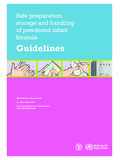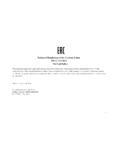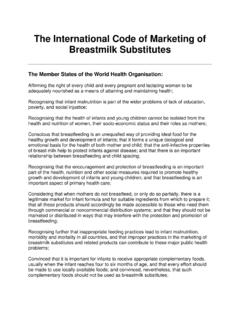Transcription of How to Prepare Formula for - World Health Organization
1 How to Prepare Formula for Bottle-Feeding at Home Printed in Ireland This document is published by the Department of Food Safety, Zoonoses and Foodborne Diseases, WHO, in collaboration with the Food and Agriculture Organization of the United Nations (FAO). E-mail: Web site: World Health Organization , 2007. This document was prepared in collaboration with the Food Safety Authority of Ireland. 1. New safety advice Powdered infant Formula is not sterile1. It may contain bacteria that can cause serious illness in infants. By preparing and storing powdered infant Formula correctly, you can reduce the risk of illness.
2 This leaflet contains new information to help you Prepare bottle feeds from powdered infant Formula as safely as possible. Breast is best The World Health Organization (WHO) recommends that infants are exclusively breastfed for the first six months of life. Babies who are exclusively breastfed will get the best start for growth, development and Health . Infants who are not breast fed need a suitable breast-milk substitute, for example, infant Formula . 1 FAO/WHO. 2007. Safe preparation, storage and handling of powdered infant Formula : guidelines. Available at: 2.
3 Cleaning, sterilizing & storing It is very important that all the equipment used to feed and to Prepare feeds for infants (for example, bottles, teats, lids) has been thoroughly cleaned and sterilized before use. Cleaning and sterilizing equipment removes harmful bacteria that could grow in the feed and make infants ill. Cleaning Step 1. Wash your hands with soap and water and dry using a clean cloth. Step 2. Wash all feeding and preparation equipment thoroughly in hot soapy water. Use a clean bottle and teat brush to scrub the inside and outside of bottles and teats to make sure that all remaining feed is removed from the hard-to-reach places.
4 Step 3. Rinse thoroughly in safe water. 3. Sterilizing Cleaned equipment can be sterilized using a commercial sterilizer (follow manufacturer's instructions), or a pan and boiling water: Step 1. Fill a large pan with water. Step 2. Place the cleaned feeding and preparation equipment into the water. Make sure that the equipment is completely covered with water and that no air bubbles are trapped. Step 3. Cover the pan with a lid and bring to a rolling boil, making sure the pan does not boil dry. Step 4. Cleaning Sterilizing Storing Keep the pan covered until the feeding equipment is needed.
5 Storing Wash and dry your hands before handling sterilized equipment. It is recommended that you use sterilized forceps for handling sterilized equipment. If you remove feeding and preparation equipment from the sterilizer before you need it, keep it covered in a clean place. Fully assemble feeding bottles if you remove them from the sterilizer before you need them. This prevents the inside of the bottle, and the inside and outside of the teat becoming contaminated again. 4. How to Prepare a bottle feed Step 1. Clean and disinfect a surface on which to Prepare the feed.
6 Step 2. Wash your hands with soap and water, and dry with a clean or disposable cloth. Step 3. Boil some safe water. If using an automatic kettle, wait until the kettle switches off. If using a pan to boil water, make sure the water comes to a rolling boil. Step 4. Read the instructions on the Formula 's packaging to find out how much water and how much powder you need. Adding more or less Formula than instructed could make infants ill. Step 5. Taking care to avoid scalds, pour the correct amount of boiled water into a cleaned and sterilized feeding bottle.
7 The water should be no cooler than 70 C, so do not leave it for more than 30 minutes after boiling. Step 6. Add the exact amount of Formula to the water in the bottle. 5. Step 7. Mix thoroughly by gently shaking or swirling the bottle. Step 8. Immediately cool to feeding temperature by holding the bottle under cold running tap water, or by placing in a container of cold or iced water. So that you do not contaminate the feed, make sure that the level of the cooling water is below the lid of the bottle. Step 9. Dry the outside of the bottle with a clean or Bottle feeding - How to Prepare a bottle feed disposable cloth.
8 Step 10. Check the temperature of the feed by dripping a little onto the inside of your wrist. It should feel lukewarm, not hot. If it still feels hot, cool some more before feeding. Step 11. Feed infant . Step 12. Throw away any feed that has not been consumed within two hours. Warning: Never use a microwave to Prepare or warm-up feeds. Microwaves heat unevenly and may cause hot spots' that could scald the infant 's mouth. 6. Can I store bottle feeds to use later? It is safest to Prepare a fresh feed each time one is needed, and to consume immediately. This is because prepared feeds provide ideal conditions for bacteria to grow - especially when kept at room temperature.
9 If you need to Prepare feeds in advance for use later, they should be prepared in individual bottles, cooled quickly and placed in the refrigerator (no higher than 5 C). Throw away any refrigerated feed that has not been used within 24 hours. Warning: If you do not have a refrigerator it is not safe to Prepare feeds in advance - always Prepare a fresh feed as it is needed. How do I re-warm refrigerated bottle feeds? Remove a bottle of feed from the refrigerator just before it is needed. Re-warm for no more than 15 minutes. Feeds can be re-warmed by placing in a container of warm water, making sure the level of the water is below the top of the cup.
10 Occasionally shake or swirl the bottle to make sure that it heats evenly. Check the temperature of the feed by dripping a little onto the inside of your wrist. It should feel lukewarm, not hot. Throw away any re-warmed feed that has not been consumed within two hours. Warning: Never use a microwave oven to re-warm feeds. Microwave ovens heat unevenly, and may cause 'hot spots' that can scald the infant 's mouth. 7. Can I bring pre- prepared feeds with me when I. am travelling? Yes - but make sure the feed is cold before it is transported, and is kept cold during transport.













